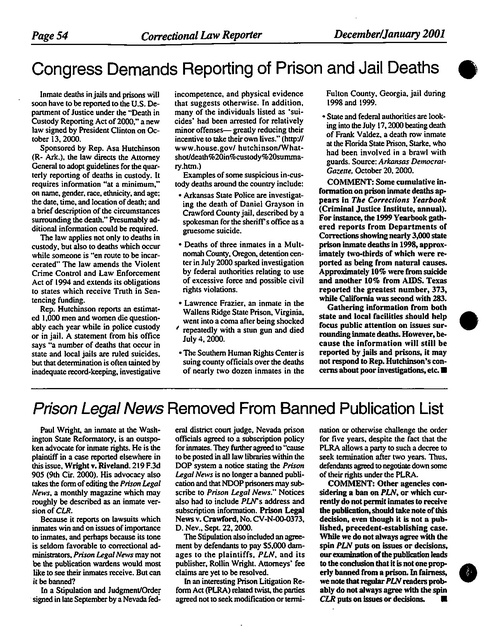Correctional Law Reporter Pln Wins Suit Pg-54 Dec-jan 2001
Download original document:

Document text

Document text
This text is machine-read, and may contain errors. Check the original document to verify accuracy.
Page 54 Correctional Law Reporter December/January 2001 Congress Demands Reporting of Prison and Jail Deaths Inmate deaths in jails and prisons will soon have to be reponed to the U.S. Department of Justice under the "Death in Custody Reporting Act of 2000," a new law signed by President Clinton on October 13, 2000. Sponsored by Rep. Asa Hutchinson (R- Ark.), the law directs the Attorney General to adopt guidelines for the quarterly reporting of deaths in custody. It requires information "at a minimum," on name, gender, race, ethnicity, and age; the date, time, and location of death; and a brief description of the circumstances surrounding the death." Presumably additional information could be required. The law applies not only to deaths in custody, but also to deaths which occur while someone is "en route to be incarcerated" The law amends the Violent Crime Control and Law Enforcement Act of 1994 and extends its obligations to states which receive Truth in Sentencing funding. Rep. Hutchinson reports an estimated 1,000 men and women die questionably each year while in police custody or in jail. A statement from his office says "a number of deaths that occur in state and local jails are ruled suicides, but that determination is often tainted by inadequate record-keeping, investigative incompetence, and physical evidence that suggests otherwise. In addition, many of the individuals listed as 'suicides' had been arrested for relatively minor offenses- greatly reducing their incentive to take their own lives." (http:// www.house.gov/ hutchinson/Whatshot/death%20in%custody%20summary.htrn.) Examples of some suspicious in-custody deaths around the country include: • Arkansas State Police are investigating the death of Daniel Grayson in Crawford County jail, described by a spokesman for the sheriffs office as a gruesome suicide. • Deaths of three inmates in a Multnomah County, Oregon, detention center in July 2000 sparked investigation by federal authorities relating to use of excessive force and possible civil rights violations. • Lawrence Frazier, an inmate in the Wallens Ridge State Prison, Virginia, went into a coma after being shocked I repeatedly with a stun gun and died July 4, 2000. • The Southern Human Rights Center is suing county officials over the deaths of nearly two dozen inmates in the • Fulton County, Georgia, jail during 1998 and 1999. • State and federal authorities are looking into the July 17,2000 beating death of Frank Valdez. a death row inmate at the Rorida State Prison. Starke. who had been involved in a brawl with guards. Source: Arkansas DemocratGazette, October 20. 2000. COMMENT: Some cumulative infonnation on prison inmate deaths appears in The Corrections Yearbook (Criminal Justice Institute, annual). For instance, the 1999 Yearbook gathered reports from Departments of Corrections showing nearly 3,000 state prison inmate deaths in 1998, approximately two-thirds of which were reported as being from natural causes. Approximately 10% were from suicide and another 10% from AIDS. Texas reported the greatest number, 373, while California was second with 283. Gathering information from both state and local facilities should help focus public attention on issues surrounding inmate deaths. However, because the information will still be reported by jails and prisons, it may not respond to Rep. Hutchinson's concerns about poor investigations, etc. • • Prison Legal News Removed From Banned Publication List Paul Wright. an inmate at the Washington State Reformatory. is an outspoken advocate for inmate rights. He is the plaintiff in a case reported elsewhere in this issue. Wright v. Riveland. 219 F.3d 905 (9th Cir. 2ooo). His advocacy also takes the form of editing the Prison Legal News. a monthly magazine which may roughly be described as an inmate versionofCLR. Because it reports on lawsuits which inmates win and on issues of importance to inmates. and perhaps because its tone is seldom favorable to correctional administrators. Prison Legal News may not be the publication wardens would most like to see their inmates receive. But can it be banned? In a Stipulation and Judgment/Order .signed in late September by a Nevada fed- eral district court judge. Nevada prison officials agreed to a subscription policy for inmates. They further agreed to "cause to be posted in all law libraries within the DOP system a notice stating the Prison Legal News is no longer a banned publication and that NDOP prisoners may subscribe to Prison Legal News." Notices also had to include PINs address and subscription information. Prison Legal News v. Crawford. No. CV-N-QO-0373. D. Nev., Sept. 22. 2000. The Stipulation also included an agreement by defendants to pay $5.000 damages to the plaintiffs. PLN. and its publisher. Rollin Wright. Attorneys' fee claims are yet to be resolved. In an interesting Prison Litigation Reform Act (pLRA) related twist, the parties agreed not to seek modification or termi- nation or otherwise challenge the order for five years. despite the fact that the PLRA allows a party to such a decree to seek termination after two years. Thus. defendants agreed to negotiate down some of their rights under the PLRA. COMMENT: Other agencies considering a ban on PLN, or which currently do not pennit inmates to receive the publication, should take note of this decision, even though it is not a published, precedent-establishing case. While we do not always agree with the spin PLN puts on issues or decisions, our examination ofthe publication leads to the conclusion that it is not one properly banned from a prison. In fairness, we note that regular PLN readers probably do not always agree with the spin CLR puts on issues or decisions. • •





